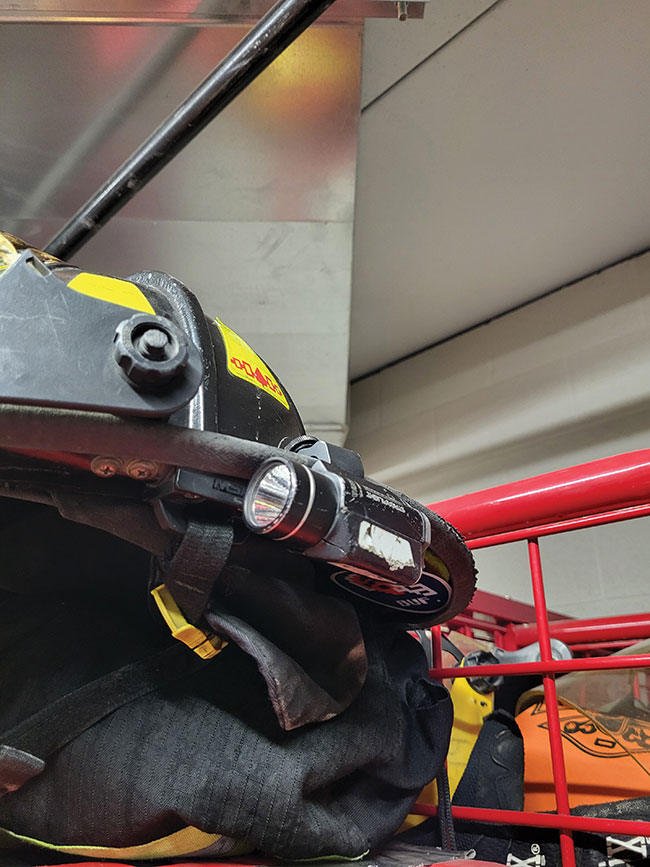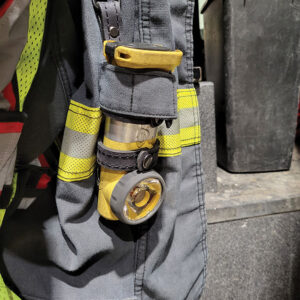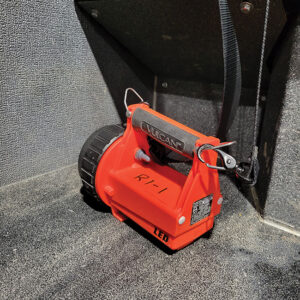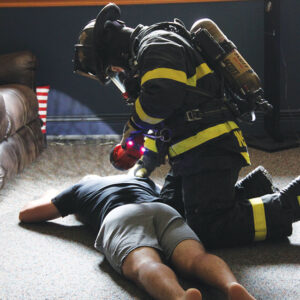
Features
Response
Back to Basics: Which flashlight is best?
March 22, 2024
By Mark van der Feyst
 Photo 1
A helmet light designed to be small and compact, but with a powerful beam of light. PHOTOS: Mark van der Feyst
Photo 1
A helmet light designed to be small and compact, but with a powerful beam of light. PHOTOS: Mark van der Feyst Which flashlight is the best one to carry and use? This is the question that many firefighters ask and have varying opinions about – some good opinions and some not-so-good. Regardless of where you stand and which one you want to use, every firefighter needs to carry at least one flashlight, if not two of them. That is my opinion, and I will explain why and which ones I recommend.
The first type of flashlight that is available is pictured in photo 1. This is a helmet mounted type of light. It is designed to be small and compact, but with a powerful beam of light. There are various versions of these types of helmet lights, some are a little bigger in length, some are designed to sit above the helmet brim, some sit well below the brim, some are going to be mounted on the front of the helmet wrapped around and below the helmet leather front.
The lights that are mounted on the sides, above or below the brim are a target for entanglements. It does not take much to entangle a firefighter in a residential structure, and these little devices are prime for getting caught. Even though they are not a permanent fixture of the helmet, it will still create a snag hazard and cause the firefighter undue stress.
These little lights are going to be light in weight, but they will still create an unbalance in the weight distribution of the helmet. The ones that are mounted on the front with the battery packs in the rear add more weight overall to the helmet. Another drawback to these types of lights is the position the lights are in – right at eye level. Who enjoys getting high beams in their eyes when someone is speaking to you with this light turned on? They blind people when speaking to them. Seeing as they are eye level, when working in a zero or limited visibility environment, if you are looking down at the ground, the light is only going to illuminate the area where your eyes are looking – which is not going to be that far. In essence, these lights are not that beneficial to the firefighter.
The second type is pictured in photo 2. This type of light is a traditional right-angle flashlight. In the photo, the flashlight is positioned upside down to offer the firefighter a better advantage of being seen, to use the beam of light to aim low on the ground in front of the firefighter and reduce the position of where it sits on the front of the jacket for better comfort. The light does not have to be positioned like this and can be positioned upright if desired.
This type of flashlight is considered to be a personal light designed for personal safety and alerting others for help. This type of flashlight is not considered a search flashlight, just like the first helmet light. When a firefighter finds themselves in trouble, such as when they are lost, trapped, or injured, and they need to call for help, this type of flashlight can be used to summon help. It is bright enough and big enough to be noticed by others and the battery run time will be longer than that of a helmet light. Due to the location of the light on the jacket, it is easier for the firefighter to grab and use when calling for help.
The right-angle flashlight can be used for searching but it is limited in mobility as it is attached to the front of the jacket. It has a limited range of motion with its positioning. The one type of flashlight that every firefighter needs to carry is a right-angled flashlight.
The third type is pictured in photo 3. This type of light is a box light. The box light is a traditional flashlight and is designed primarily for searching. The light can be carried over the shoulder on the outside of the jacket and under the SCBA, resting the flashlight on the side of the hip. It can be either on the left or right side of the hip depending upon the preference of the firefighter.
The box light is large enough to cast a bright beam in the environment of the search. The searching firefighter can maneuver the flashlight to any position they need it to illuminate the area of the search without impeding their progress or not being able to reach it due to its location – tucked away high on the coat like the right-angled flashlight.
In photo 4, an example of the box light is shown in terms of how it can be used to locate, confirm, and check for other occupants. The firefighter can easily locate the box light, move it around as needed to illuminate the area around and underneath the occupant. The box light is truly a search light.
The box light comes in a variety of sizes and styles. Now, most are LED models which make them brighter, and also lithium-ion battery powered which makes them lighter to carry. Some firefighters will attach the box light to a ladder belt worn around the waist of the firefighter, with others using the shoulder strap and others clipping it right to the SCBA waist belt. Regardless, it is located low on the firefighter where it is needed and will not blind you when speaking to other people.
So, which flashlight is the best to use? it is going to be the box light coupled with the right-angled flashlight. These two lights will serve the firefighter’s best interest in their survival, and also for the occupant’s survival to be located and rescued.
Mark van der Feyst has been in the fire service since 1999 and is currently a firefighter with the FGFD. Contact him at Mark@FireStarTraining.com.
Print this page


